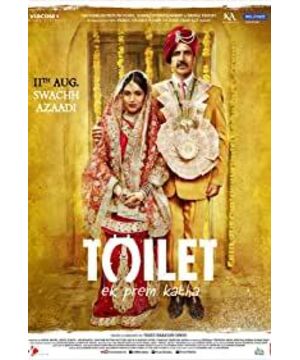I stared at a 2nd century AD Kushan Empire-era "poetry piece". This is an incomplete disc made of three broken curved pottery pieces, with a palm-sized hole in the middle, and the pottery-red surface is mottled and uneven-the surface that was once very smooth after being rubbed by countless butts finally finally Rough again after the burial of history. The explanatory text on the side reads: Unearthed from a nunnery; 80 cm in diameter, with a middle defecation hole of 17 cm. Note: There are additional foot rests on both sides.
I couldn't figure out the ergonomic principles of the device in front of me, but I firmly believed that I had seen the world's earliest ceramic toilet, which gave me a feeling of being from the Stone Age.
The Sulabh International Toilet Museum in New Delhi's Palam district is small, but full of humor and poetry about toilets. It not only shows the different toilet civilizations and toilet etiquette in different countries in the world, but also tells visitors who the author of the poem "To the Toilet" is. In the exhibit, a model of a two-story toilet in the 1920s in the United States is discriminatory with the words "manager" written on the door on the second floor and "employee" on the first floor.
A display board on the side is a "recipe" for toilet use: if you have a bowel movement outdoors and there is no toilet nearby; or because you don't have toilet paper on hand, you can't respond to the "call of nature", thus causing huge discomfort, Try the following method: Use a pen, or any blunt object, to press firmly on the palm and move it three or four times in the direction shown, the "pressure" will be relieved immediately.
More fun than all this history and anecdotes about toilets, perhaps, is the fact that this museum is located in India - a sanitation-laggard place where far fewer people have access to the toilet than there are cellphones, and the way ( For example, flushing with water without using toilet paper after work) is often joked by people from all over the world.
When I learned that there is such a toilet museum in New Delhi, my instant reaction was a sense of irony, "So, before building enough toilets, the Indians built a toilet museum?" This is what drove me to Find out why.
When I first traveled to the country a little over a year ago, as I stepped out of the subway entrance of Delhi railway station, I was struck by the unparalleled smell that filled the run-down streets of Paharganj. The smell is a mix of no less than a million sources, three of which are important contributors: cow dung left by sacred cows, curry wafting from street kitchens, and open roadside toilets. In many cities in India, toilets are somewhere between what is and what is not, indoors and outdoors, reality and surreal. The "basic" toilet is basically just a wall on the side of the road, with a few grooves made of bricks, which is simple.
For foreigners who dare to try, it is not easy to stay focused when peeing, because behind you is a torrent of cars, tugs, pedestrians, and bullock carts. The "realistic model" is to cover a few plastic plates behind and above the basic model to enclose a general layout of a toilet, which has a certain degree of concealment and focus. Of course, India also has many modern toilets, such as in subway stations and shopping malls. Sulabh, the NGO behind the museum, is an important modern toilet builder.
In my travel experience, perhaps only the toilet conditions in Tibet are comparable to those in India. The natural conditions in Tibetan areas are harsh, and many toilets are built in a very rough and simple way, and most of them are built on cliffs. These toilets do not need to be taken care of by humans, and are completely inherited and degraded by nature, and the smell is naturally brewing for many years. But the cliff toilets in Tibet not only stink the toilet users, but also give people a sense of heroism (imagine the scene of your Baba falling from a height of ten meters or even dozens of meters). In India, being overwhelmed by the stench produces only a delirium hallucination.
The reason Indians are so casual about toilets is largely "thanks" to their habit of defecation in the open at some point in time. If you travel to rural India and see the villagers in the picture below walking out of the village with small white water jugs in groups, please do not ask them what they are doing. Yes, they are doing "that thing", and the water in the small white kettle is for cleaning after the toilet.
As this ancient country gradually entered modern civilization, this primitive method has become a symbol of the country's backwardness in the eyes of modern Indian elites, a disease of civilization, and has begun to be severely criticized.
According to the Indian writer VS Naipaul, the scene of Indians squatting in a row on the river bank in the early morning is like "Rodin's sculpture "The Meditator" is as eternal." In the book "Dark Realms", he explicitly described this phenomenon:
"In Goa, in the early morning, you might want to go out for a walk, take a walk along the Boulevard along the Manduwe River. Look down, and you see the water's edge six feet from the road, squatting long A row of figures that, at first glance, looks like clumps of seaweed washed up on the shore. On this point, the inhabitants of Goa and the citizens of the Roman Empire agree: pooping is a social activity; They have to squat together and chat while pulling.”
Mahatma Gandhi, who returned from South Africa, noticed at the National Congress held by the Congress Party that those delegates attending important political meetings, knowing that the cleaners had left work and no one was cleaning their excrement, were still openly arguing in the corridors.
This year's Bollywood film "Toilet Hero", nominated for three Indian Film Audience Awards, tells the story of a young generation in India who started a revolution when they couldn't stand the habit of open defecation. Like most Indian films, "Toilet" is humorous and sincere, torn back and forth between shocking reality and a kind of idealism, telling a story that is quintessentially Indian: newlyweds who soon start their divorce, and The bride's primary reason for applying for a divorce was that the groom's house did not have a toilet. Such a divorce case has attracted media reports and special attention from the court, reflecting the embarrassing reality of India in the field of public health.
In fact, the story in this film is not magical in India at all: just in the "India Times" on March 29 this year, I read this news: Several government employees in the Delhi Noida area were forced to report to the authorities. Apply for transfer on the grounds that there are no toilets available around the working hours.
Now, even in rural areas, more and more young Indians are aware of the gap between open defecation and modern hygiene. Women in this country, in particular, are increasingly hungry for clean and hygienic toilets. After Modi became the president of India in 2014, the SwachhBharat Mission (Clean India Movement) was launched across the country. One of the important elements was the construction of a large number of public toilets in households and communities to change the habit of open defecation. The campaign aims to make public toilets free nationwide by October 2, 2019, the 150th anniversary of the birth of Mahatma Gandhi, who was also a pioneer in calling on Indians to maintain clean and hygienic habits, and spend $30 billion in rural India Build 90 million toilets.
After the campaign was launched, there was an upsurge in the construction of toilets in India. Some slightly exaggerated headlines can often be read in Indian newspapers, such as "32,000 toilets built in 120 hours". Even the Bollywood star Salman Khan, who was locked in prison not long ago, was involved in a poaching lawsuit: he complained slightly sarcastically that there was only one toilet in the public cell where 9 people were kept, and he also said that after he was released from prison Willing to respond to the national call to help prisons build more toilets.
The museum is set up and run by a group called Sulabh, whose founder Bindeshwar Pathak is passionate about promoting toilets in rural India. He invented a convenient and practical "twin-pit toilet" that costs as little as $15 to build and uses only 1.5 liters of water per flush (regular toilets take about 12 liters). Because of its low cost and easy construction, it is very suitable for promotion in rural India.
The museum also displays many "double pit latrines" of different scales. A chubby female instructor asked me to stand on the side of one "pit" and stand on the side of the other "pit", and began to explain to me endlessly: "These two pits are used alternately, and when one pit is in use, Another filled pit is covered up and fermented for two years and turned into fertilizer…” She told me they have built 1.5 million such toilets in rural India so far, “Our Dr Pathak is called India The 'toilet Guru' (Guru, meaning master, teacher) Oh!" She also found a thick brochure and gave it to me, on the cover, Prime Minister Modi and this Dr. Pathak together for a " Photo of the foundation stone laying of the Double Pit Toilet.
At that moment, it dawned on me that the Indians didn't build this museum to show how beautiful, chic and different their toilets are, but just because a lot of people don't realize they need a toilet.
Therefore, this museum has painstakingly collected many historical documents to confirm that Indians have had very good hygiene habits since ancient times.
For example, the display panels in the hall start from the Harappa and Mohenjo Daren civilizations before 2500 BC, which proves that India has a long tradition in toilet culture and toilet etiquette. The "toilet tablet" used by the nuns mentioned at the beginning of this article is just one example.
The most peculiar thing in the exhibition materials is the regulations on the place, time, squatting position, and process of toileting in the ancient Indian classic "The Code of Manu":
"Married persons should sing a hymn before going to the toilet and: 1. Before going to the toilet, a "sacred thread" should be wrapped in a small circle and placed on the right ear.) 2. Before defecation, a cloth should be applied Cover your head. If there is no fabric around, you should wrap the holy thread around the top of your head and hang down your left ear. 3. Be silent during defecation, and face north during the day and south at night. 4. Don't touch it during defecation 5. After defecation, hold the water tank with the right hand and wash with the left hand.”
There are two additions under the norm: "(1) celibates should be twice as strict as married; yogis should be three times stricter; sages should be four times stricter. (2) These norms apply only during the day, and the frequency of nighttime washings should be Halved, further halved during travel, patients should act according to their ability.”
Another little poem illustrates the relationship between graceful defecation and religious cleanliness, along the lines of:
1. Urine should be 10 hands away from the water source.
2. The stool is 100 hands away.
3. When there is a river or temple nearby, you should urinate at least 40 hands away and defecate at least 400 hands away.
4. You should not defecate in running water or rivers. The water used for cleaning should be brought with you and away from the river when cleaning.
The problem is that these seemingly inexplicable norms, mixed with religious concepts, are far from modern concepts of hygiene. Rather than focusing on the cleanliness of the body and the environment, they are more concerned with avoiding religious taboos that we can hardly understand.
In "Toilet", the male protagonist complained that "their country is caught in a religious game", because the biggest obstacle preventing him from building a family toilet and saving his marriage crisis is his father's words: How can you What about building toilets in the same yard where we worship Goddess Tulsi?
This is not a joke. A news article published by The Times of India on April 11 this year wrote: A batch of public toilets just built caused public anger, and the authorities demolished them overnight because the brick manufacturer who built these toilets was named "Ram", and every Each brick has the "Ram" logo printed on it. "Ram" is the name of the god Rama, widely worshipped in Hinduism. It is blasphemous to use the bricks with his name on them to build toilets! This reminds me of the domestic movie "Bi Sheng" I watched when I was a child: Bi Sheng, who invented movable type printing, was persecuted by conservatives, because - how can the "movable type" that has just printed foul language be retyped and used to print sage books Woolen cloth?
The gods require cleanliness, and the filth in the toilet will undoubtedly cause pollution, and the two are incompatible; but on the other hand, religious cleanliness does not necessarily lead to cleanliness, and the two may even run counter to each other.
As I left the toilet museum, the holy city of Varanasi in India came to my mind blasphemously. Every devout Hindu who goes there for a pilgrimage will go down to the Ganges River to bathe without hesitation, although the Ganges water has long been turbid due to the massive dumping of industrial and domestic waste upstream. The Ganges is sacred, and it brings religious cleansing that has nothing to do with hygiene.
(This article was first published in VICE China)
--------------------------------
View more about Toilet: A Love Story reviews











